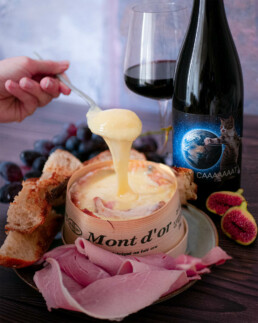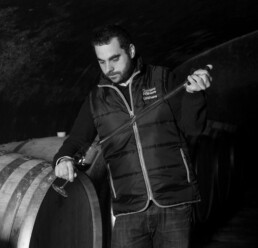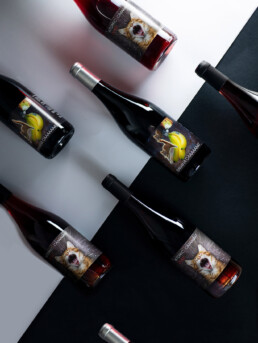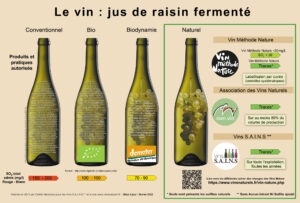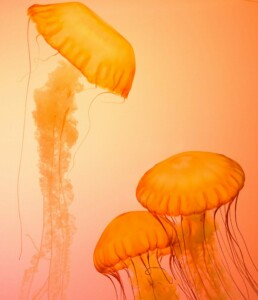Indigenous yeasts, exogenous yeasts
It’s the cat tamer Chris. Today I’m going to tell you why I like indigenous yeasts… to the point where I shout about them to my friends! True story… for when we get together for a beer (because being shouted at might be one of your fantasies?).
First of all, what is yeast used for in wine?
Yeast is a single-cell fungus, a micro-organism, which enables alcoholic fermentation by transforming the grape’s sugar into alcohol. This is why the more sunshine a vintage gets, the sweeter the grape becomes (thank you photosynthesis), and higher the alcohol percentage in the wine is. Makes sense! and it’s perfectly natural.
Secondly, let’s learn the terms:
- Indigenous yeasts aka “natural yeasts” aka “wild yeasts” generally come from the grape. They can also come from the equipment and the environment in the wine cellar. We talk about yeast in the plural because you can find between 5 and 20 different strains during spontaneous fermentation. They vary throughout fermentation and from one year to another.
- Exogenous yeasts, called “chemical”, “oenological” or “added” yeasts, are all natural too (yeast cannot be created artificially, it’s grown) but they’re chosen. There is a huge amount (+250) and they are marketed based on the properties the buyer desires: revealing aromatic compounds, extracting polyphenols, controlling the fermentation temperature, flavouring (yuck), etc.
In these exogenous yeasts, there are two main categories:
-
- Neutral, it kick starts fermentation and dominates its environment
- Aromatic, which we find a lot in mass-produced wines, like “grapefruit flavoured” rosés (God, help us)
You saw at the top that without yeast, there’s no fermentation, so no wine 😱.
The best is spontaneous fermentation, fermentation which starts on its own thanks to indigenous yeasts. But it’s not as simple as it seems! Because there’s life everywhere and wine yeasts are in competition with mould, other yeasts like brettanomyces (you know the ones, that stable smell), oxidative yeasts… I could go on, an entire bacteria ecosystem which can alter the wine. Making a “natural” wine is like painting a Rembrandt (see for yourself).
Are you following? So even if the indigenous yeasts have a certain authenticity, as the yeast is an integral part of the terroir ("terroir is 50% soil, climate, exposure and 50% indigenous yeasts" says Jules Chauvet), we always prioritise taste, the quality of the wine. So when there’s a risk of a deviation here – for example when it’s been a particularly rainy year which leads to some of grapes on the vine rotting – even if I'm not for it, I understand the use of neutral exogenous yeasts. They help to trigger fermentation avoiding any deviation. And so we prioritise the taste, the intrinsic quality of the wine, all while protecting an expression of the terroir.
To sum up, I really like the idea of indigenous yeasts, because they line up with my quest. And yet, it’s impossible for 99.99% of people to distinguish between indigenous yeasts and neutral exogenous yeasts in the taste of a bottle; compared to aromatic yeasts, which can be identified as they often flavour the wine in an unsubtle way.
So, the next time you go to see your wine merchant, trust them and don’t try to put them on the ropes with sulphur and indigenous yeasts. It’s more complicated than it seems… and if they’re good (we know loads, have a look), they’ll only recommend good bottles! Oh, and then be honest with yourself, would you slap Mike Tyson?
Thanks for your attention. Now, if you want to share your opinion, join us on Instagram.
Wine & Cheese pairing
The marriage of wine and cheese is a centuries-old tradition, an ode to fine dining! In France, the land of 400 cheeses, there are many pairings options, here are a few:
Hard cheeses
Hard cheese and dry white wines: Comté, Beaufort, Salers, Emmental and Gruyère are the perfect companions for dry white wine, whether they tend to be oxidative or not, like the wines of Jura and Southern Burgundy. Ossau-iraty, Manchego, Parmesan and Pecorino come alive with more robust dry white wines like Côtes de Gascogne (dry), the Chenin Blanc of Cahors, the whites of Languedoc.
Step off the beaten track with Sunny Caaaaaaat.
Goat’s cheeses
Goat’s cheese with a Loire white wine: Anjou Noir, Sancerre, Pouilly Fumé, Quincy, Reuilly, Menetou-Salon… the fruity notes of these wines will glorify the light and fresh notes of goat’s cheeses. Pairings with light rosés will enhance the wine!
Adventurous? Try a pairing with Cosmic Caaaaaaat!
Soft cheeses
Soft cheese and red wine: Brie and Camembert are delicious with a light and delicate red wine from Burgundy, Beaujolais, Alsace or Loire. The soft texture of these cheeses will envelop the light tannins, their flavours will reveal the fruit, sometimes even the floral notes of the wines.
Blue cheeses
Blue cheese and a red wine or a sweet white wine: for lovers of reds with cheese, opt for a Roquefort or a Gorgonzola paired with red wines from Corsica, Languedoc-Roussillon and the Rhône Valley. The black fruit and spicy aromas of these wines will envelop the intense and spicy aromas of the blue cheeses.
Why not a Karate Caaaaaaat?
For Gex and Termignon blue cheeses, or Picón Bejes-Tresviso, a sweet wine (ideally botrytised) will reveal a surprising pairing for the taste buds: the creaminess from the residual sugar in the wines will harmonise with the delicacy of these cheeses, exalting the complex bouquets of the wine: honey, spices, dried and confit fruits, toasted brioche, nuts, orange blossom, citrus…
Conclusion
There is no hard-and-fast rule, there are a thousand possible pairings; the personal tastes and preferences being the main factor in your choices. So, if you’re unsure, don’t think about it too much: cheese and wine from the same region! It’s usually a winning team.
Interview with Romain Paire, Domaine des Pothiers, Banana Caaaaaaat partner 😻
Making a four-handed wine is about combining the winemakers’ expertise, which is rooted in the terroir, with that of a former globe-trotter who tastes everything, smells everything (like a cat).
Romain
Can you describe yourself in a few words?
Domaine des Pothiers is a polyculture family farm. The farm has a history, it’s been in the family for several centuries with a large winemaking activity and a cattle breeding section (Limousine and Jersey cows). I wanted to keep up the cattle farming to preserve an gricultural dimension, and also because it’s part of the farm’s biodynamic world.
How did you get into winemaking?
I didn’t really have a eureka moment because I had always seen my dad working in the vineyard and making wine, I always enjoyed working with him. One day I told myself I’d carry on with the job, that I’d take over the farm. I think I always had that feeling inside.
How do you work in the vineyard and the cellar?
With respect for nature, by maintaining the balance. We work with Biodynamics and try to have as little impact on the natural environment as possible. We grow the vines as gently and respectfully as possible. In the cellar, we try to work with the lowest amount of inputs, even with none when we can, to respect the grape, the wine and its consumer.
The wines
For you, what is essential to creating a good wine?
Good grapes of course!
Making good wine is about a multitude of little details. Some seem insignificant but are important. It requires care and rigour. Above all, good wine starts with the vine and the quality of the grape, then it's up to us to make the most of it.
Is there a message behind your wines?
No, I’m not into politics. I don’t think there’s a message behind my wines. What I try to convey is enjoyment, wine is about celebrating, craziness, good times and I definitely don’t want my wines to be dogmatic!
What would you like to say to anyone who wants to become a winemaker?
Go for it! Go for it because it’s not impossible. If you want to do it, there’s no reason it won’t work. There’ll obviously be some work (laughs) but you have to go for it!
Dreams
What did you enjoy the most when co-creating Banana Caaaaaaat?
I like the relationship we have with Christophe because we work with trust and that pushes me to make different wines, which takes me out of my comfort zone. I understand what Christophe wants and how he sees wine, which is sometimes different to how I see it. So I work under his vision and this forces me to ask myself some interesting questions.
Do you have a winemaker’s dream to share with us?
My goal is to try to always do better in terms of quality and not to develop in quantity.
I’d like to have a little more finesse, and improve some details.
Maintain the polyculture aspect, and maybe even develop it, try to have something larger, add new things to the farm, maybe visits or a restaurant or something. Diversify the farm even more, doing it in an intelligent, environmentally friendly and social way.
Thank you for the chat Romain.
Thanks to Domaine des Pothiers for being our partner.
We love you!
What is natural wine?
Simply put
By definition, wine is a cultural product. You can’t stumble across some wine out in the wild, it requires the intervention of a winegrower to make it from grapes (those guys are natural).
So simply put, natural wine is a wine which is made as naturally as possible:
- No synthetic products: not in the vineyards, not in the cellar, anywhere
- Manual harvesting
- A total sulphur/SO2 level lower than 40mg/L
In other words, we aim for pure fermented grape juice. Yes, this should always be the case, but it’s not that simple. Nature is capricious and we don’t follow its rhythm anymore.
A bit of History
The history of naturally produced wine goes back to Antiquity, well before the arrival of 20th century industrial winemaking techniques, which were doubly amplified by the Second World War: the rapid development of petrochemicals (notably for armaments) and the race for yield (during reconstruction).
In France in the 1980s, the movement for a return to natural wine production was spearheaded by such illustrious figures as the Beaujolais "négociant-éléveur" Monsieur Jules Chauvet, who was also a writer, scientist and fine wine taster. Jules Chauvet was a pioneer, one of those rare human beings for whom the adjective "genius" means something. As early as the 1950s, he was producing natural wines. His methods slowly caught on with curious minds such as Jacques Néauport, itinerant wine producer, and the emblematic Beaujolais winemaker Marcel Lapierre (and many others).
During the 90s, the natural wine movement continued to gain popularity in France, Italy and Slovenia, then spread rapidly across Europe and the world (including the USA and Australia) from the 2000s onwards.
Nowadays
Today - as the general public becomes increasingly aware of the benefits that such production brings to their health and that of our environment - many winemakers are converting their vineyards or opting from the outset for healthy agriculture and natural winemaking methods.
The image below summarises the differences in winemaking methods:
And as we are seeing a wave of greenwashing, keep one thing in mind: free wine doesn’t exist. Either we pay with cash, or we pay the price by damaging the environment.
Orange, the fourth color of wine
What is orange wine?
Orange wine, made exclusively from white grapes, is also called “skin-contact” white; a clue to the origin of this orange color coming precisely from the maceration of the skins with grape juice. Orange wine is therefore a white wine vinified like a red!
While for the majority of modern white wines, the grapes are directly pressed, those used for orange (and red) wine macerate with the skin, seeds, and sometimes stems, for a duration ranging from several days to several months. This maceration, this contact with the solid parts of the grape, gives white wine its orange color.
Origins
Contrary to what's often heard, orange wine is not a new trend. It's an ancient practice, with its modern revival dating back to the 1990s, in the Friuli-Venezia Giulia region, specifically in its cross-border area with Slovenia. The major winemakers behind this revival are Slovens: Gravner, Radikon, and Vodopivec. Since then, many wine producers have followed in their footsteps... including Caaaaaaat!
So, the first white wines were orange wines. It's difficult to pinpoint exactly when they appeared, as it seems these wines existed even before writing (which goes to show how far from a new trend this is). However, it's likely that the origin of orange wine can be traced back to Georgia – known for its terracotta amphora winemaking (qvevri), still practiced today – and then integrated into the winemaking methods of Antiquity. During this period, wine preservation was achieved through the addition of exogenous materials (pine resin, honey...) and/or prolonged maceration to extract the famous polyphenols, powerful antioxidants, from the grapes.
Today
It's not by chance that orange wine is reborn in the realm of natural wines. Tradition is alive, in perpetual motion. It accompanies societal changes, the desire for change in new generations ready to act for their well-being and that of their environment, even in the realm of pleasure.
If you want to taste one of the many examples of orange wine, start with O.G. Caaaaaaat; O.G. for "orange," O.G. for "Original Gangsta," because you now know that orange wine is the O.G. of white wines... and if you still don't understand what we're talking about with this O.G. story, go listen to Ice-T’s album released in 1991.
To learn more about orange wines, taste them at your favorite wine shops and wine bars!
Cheers!



